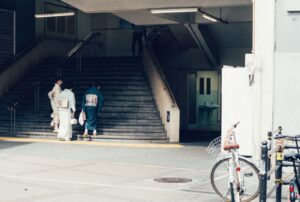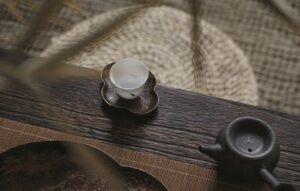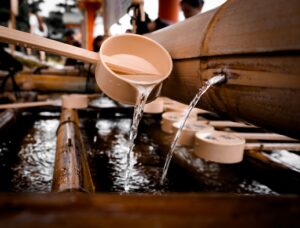Walk a Monk’s Path as a Modern Minimalist Solo Traveler

Whether we feel joy, gratitude, anger, or sadness, our minds always react to various situations with different emotions. However, instead of accepting those initial emotional impulses, the Japanese try to be more mindful. By thoughtfully changing the way we react by consciously being more neutral, we can theoretically spend our days more comfortably. A monk at a temple in Shizuoka said, “by reacting either very negatively or extremely positive means you are walking on the edges of the path. On the other hand, people should decide to be more neutral, walking firmly down the center of the path.”
While we stayed at the temple, the monk taught us that we should be aware of the mindset of walking down the middle. But it’s hard to earnestly stop your mind from automatically reacting! For example, when we received happy news from friends and family, we were also annoyed by noise made by neighbors in the next door apartments… our minds always seemed distracted, swinging left and right. We asked the monk, “How can we reduce these unnecessary mental reactions?” He replied, “Be aware of the sensations in your body.” The typical way to change your mindset is to do something else, such as listening to music or going for a stroll, but that doesn’t solve the fundamental problem. It just causes the mind to move on to another action. If you take a break from your mind or thoughts and focus only on the senses in your body, your mind’s reactions will calm down, and your stressed and frustrated mind will feel much better. Several specific methods can be done easily daily to help. The three methods listed here are not the technical names of Buddhist studies, as we asked monks and gave each method our respective names.
The first is a “Mindful Cleanse” which can be done by just closing and opening your eyes. Close your eyes and recognize the thoughts that naturally pop up in your mind, such as anger or fear of someone, anxiety about your well-being or your financial situation, etc. Keep your eyes closed for about thirty seconds to one minute. Then open your eyes, focus on your real sight, and take a good look at your surroundings. You will realize that nothing is happening in front of you right now, and you will be able to reduce your mental reaction.
The second is a “Foot Meditation,” which uses the sensation of the soles of your feet on the ground. For example, let’s say you have an angry partner or boss in front of you. Your mind will react to the person, and you will be filled with anxiety and anger. Before this happens, focus on the soles of your feet, and be aware of your presence. If you focus solely on the sensations in the soles of your feet, such as feeling the hardness or warmth of the wooden floor or the texture of the fluffy carpet, your mind will gradually stop responding and begin to calm down. Eventually, you can reduce your reactions by maintaining that peaceful state of mind and responding to the other person with the rest of your awareness. It is important to give priority to your state of mind while interacting with others, rather than being moved by them.

The last is “Walking Zen” —it teaches you to walk with a keen awareness of your feet. When you walk, you count each step in your mind and be aware of the sensation of the soles of your feet, just imagine you are connected on the earth. It helps combat unnecessary or negative thinking. Before starting to walk, decide how far and how long you want to walk; avoid talking to other people while walking; and a walk-in rhythm at a slightly faster pace, keeping your posture and breathing constantly. Some monks advocate walking 1,000 steps, but the idea is to gradually increase the number of steps at your own pace.
We personally also recommend “Silence Me-Time”. For example, try going alone to a coffee shop in a faraway town where you don’t bump into anyone you know. Even if it’s just once a week, just taking a few moments of silence without talking to anyone can help you recover and relax your mind away from external stimuli.
Talk to a Monk, Experience Real Mindful Eating the Zen Way
Women’s Only, Ease & Cheerful Temple Stay – Myokenji, Kyoto Prefecture
A cozy accommodation, this temple has only three rooms which are primarily for women travelers. It is located in a tranquil area of Kyoto, where you can escape the hustle and bustle of the city. Within walking distance, you can stroll through many other beautiful temples grounds, enjoying a mindful Me-Time moment. This serene lodging gives you a sense of history and tradition while you enjoy peace of mind. No meals are available at this temple, but there is a shared kitchen if you like to cook your food. As many temple stays do, this place accepts a maximum stay of 2 nights and 3 days, which is a great choice if you want to have enjoyable lodgings along with reasonable prices. Morning meditation sessions are available for guests every day.
Another activity in the vicinity is the Nishijin textile center. The local museum showcases over 1200 years of Kyoto’s textile history through its archives and demonstrations on traditional crafting.
ADDRESS: 514 Myokenji-mae, Shinmachi Nishi-iru, Teranouchi-dori, Kamigyo-ku, Kyoto-shi, Kyoto
Accommodation only (No food service), Cash only
Fee ¥
Brighten Your Corner of the World – Myotoku-an, Monjisenji, Ōita Prefecture
At this Tendai Buddhism sect temple, we learned the phrase “Light Up One Corner” which means to do your best and to brighten the situation you are in. The idea is that if everyone shines their light in his or her corner, it will become a one big light which can protect the world. The morning service begins with the candle-lighting of the Eternal Dharma Light. The candle flame is offered as a dedication to Mt Hiei Enryakuji in Kyoto, the headquarters of the Tendai sect. The Enryakuji’s original light has been shining for over 1,200 years. The light is kept in the inner sanctuary. It is supposed to guide you to return to yourself. The temple is also popular with worshipers wishing to pray for a child’s healthy growth and helping pass school entrance exams. You must also see the famous two Nio Guardian statues that are over 1,000 years old. They stand at the bottom of a 300 stone stairway leading to the main hall at the top. In addition, if you like to have a paper lucky charm, there is one derived from the famous priest of this sect named Ryogen (912 – 985) that is available. It has been considered to be a talisman to ward off bad plagues.
ADDRESS: 2432 Kunisakimachi Daionji, Kunisaki, Oita Prefecture
Online reservations are available
Fee ¥¥
A Cross-cultural Buddhist Experience – Kongoji Shukubo Seihoin, Nagano Prefecture
Nagano prefecture, well known for the 1998 Winter Olympics for foreigners is also known as the oldest and the largest temple in Japan called Zenko-ji. It was built in dedication to the first known Buddhist statue to be brought in the 6th century from Korea. Zenko-ji predates the establishment of the many specific schools of Buddhism that now account for the numerous temples found throughout the country.
Because of this fact, it is popularly considered everyone’s temple. It is a sect-free monastery where people of all denominations, all backgrounds, and beliefs are welcome to worship. After visiting the diverse and inclusive place of worship, a great choice to stay next is at the Korean Buddhism temple, Kongoji. Nestled among mountains and greenery of Azumino region, it is a tranquil temple lodging that serves Korean Buddhist cuisine. Traditional recipes have been handed down, including many of the most well-known Korean dishes such as a Korean rice bowl called Bibimbap and a Korean pancake called Pajyon. The accommodation has a natural Onsen (hot-spring) and offers various hands-on experiences as well.
ADDRESS: 7552-73 Hotakaariake, Azumino-shi, Nagano
Online reservations are available
Fee ¥¥
Not only Zen Meditation, Experience Many Buddhist Rituals – Temple Hotel Takayama Zenkoji, Gifu prefecture

If you are eager to learn Zen, here is a perfect place to study it. Rest your mind and soul through many Buddhist rituals lessons such as Zen meditation, Sutra copying, tracing the image of Buddha, and sound therapy (such as playing the singing bowls). You can even create your own natural incense fragrance powder named Zukou(塗香). It is relaxing to wear the Japanese traditional garment called kimono & take a stroll through the neighborhood. Yoga is also available at the main hall of the temple.
The unique ritual here is a pitch dark pilgrimage, which is called Kaidan Meguri in Japanese. You actually enter into the temple’s pitch dark underground passages! Finding an actual key lock in the darkness is said to help you overcome the fear of the dark and boost your courage. As proof of your visit to this temple, they would provide a Goshuin, which is a paper certificate. It is stamped with a red ink using a unique seal of the temple and handwritten by the monks.
ADDRESS: 4-3 Tenman-cho, Takayama-shi, Gifu
Online reservations are available
Fee ¥¥
The Pinnacle of Peace and Contentment: Mount Koya Temple Retreats, Wakayama Prefecture
Mount Koya (Kōyasan) is the monastery complex on a wooded mountaintop and the center of Shingon Buddhism. The significant religious figure Kukai introduced Shingon Buddhism to Japan in 805. He built one of Japan’s most sacred sites. The most unique and special experience you will have in this area is Ajikan(阿字觀) meditation. This means, “One look at the letter A destroys evil passions”. The Ajikan refers to a method of meditation by Shingon esoteric Buddhism and realizes that we are nothing but the universe. During the meditation, it is important to feel your breath. Feeling your breath and counting it will make it easier for you to ease your mind and let distractions go. The practice time is usually about 30 to 60 minutes. You can experience the type of meditation only in the area or in Shingon Buddhism temples in the country.
Experience a Unique Meditation Ajikan – Koyasan Fudo-in
This temple inn is located on the mountaintop of Mount Koya which is dedicated to Fudomyo-o. It is the most important of the Five Wisdom Kings and is also the symbol of determination. The temple was founded in 906 as one of twelve temples by Saiko (870-943), a high-ranking monk. The temple is also known as the main temple for the Yamashinas (an Imperial family branch) and is called “Yamashina Betsu-in”. Bifukumonin (1117-1160), the Empress of Emperor Toba (1103-1156) and a devout follower of Kobo-daishi, was buried here according to her last will and in respect for her lifetime contributions to the temple. She also donated a precious Amida-Sutra and three Amida statues.
For dinner, the famous Koya style Shōjin ryōri dishes are Goma-dofu (sesame bean curd) and Koya-dofu (freeze-dried tofu) which are great sources of protein. Needless to say, all dishes will be served beautifully and are guaranteed to be delicious.
ADDRESS: 456 Koyasan, Koya Town, Ito-gun, Wakayama
Online reservations are available
Fee ¥¥
Gluten-free Monks Dish and a Temple Night Tour – Ekoin, Wakayama Prefecture
The monks’ dish called Shōjin ryōri refers to a vegetarian meal that also excludes ingredients like garlic and green onion, which Buddhists believed excited the passions. They also created gluten-free dishes using seasonal vegetables and local delicacies. After dinner, a two- hour walking night tour (available in English) is available for a fee. A local monk who is a certified guide, will take you to the Okunoin graveyard during the night time. This is the place of rest for Kukai and many others. It is one of the most sacred places in Mount Koya. You will be enchanted by this fantastic sight, unlike some daytime tours.
This 1200-year old temple on Mount Koya is where Kukai built a five-story pagoda and enshrined Bishamonten and Fudo Myoo. Under the order of the 8th Shogun, Tokugawa Yoshimune, the temple was named Ekoin in 1704. This place is known as the family temple of Akechi Mitsuhide who was one of the most trusted vassals of very powerful warrior Oda Nobunaga.
ADDRESS: 497 Koyasan, Koya, Ito-gun, Wakayama
Online reservations are available
Fee ¥¥
Shrine Lodging: Shinto Ritual and Religious Experience
Some of you might already know Shinto is Japan’s native belief system and predates historical records, which translates as “the way of the gods”. Shrines are the places of worship for this concept. Expressions of Shinto beliefs toward nature include the recognition of divine spirits in trees that are more than 100 years old, large mountains, and tall waterfalls, as well as celebrations highlighting each season. Since Shinto is more about rituals than faith, Japanese people do not generally consider Shinto as a religion and more that it is simply an aspect of Japanese life.
Shrine Lodging provides you with a different type of religious experience versus a Buddhist temple stay. For a temple stay, Zen meditation is an important part of Buddhist fundamental training. In contrast, for a shrine stay, connecting deeply with nature, such as hiking the mountains, is an essential aspect of Shinto practice.
A Japanese religious tradition of mountain ascetic practices evolved with folk beliefs with indigenous Shinto, Buddhism, and Taoism, named Shugen-dō practices. The mountains were considered to be deities, and thus, a unique Japanese form of mountain worship was established.
The highest power spot in western Japan – Ishizuchi Shrine, Ehime Prefecture
This shrine was built on the sacred mountain of Mt. Ishizuchi. It stands on the mountainside, consisting of four parts; one at the summit; two on the mountainside; and one with the head shrine standing on the foothills. In the Nara period (710-794), this mountain thrived as a place for ascetic practices which include the studies of the Shingon school founder Kukai (774–835). Three important teachings are given at the shrine while climbing this mountain, which is considered sacred and an object of worship. The first is Shubatsu(修祓), a form of purification of the body and soul by bathing in the sea, rivers, or waterfalls before climbing.

The second is Shugyo(修行 ) which focuses on deep mind and body training. One ritual involves donning a white robe (representing purity) and climbing this holy mountain while reflecting upon yourself and/or the gods. Toward the top of the mountain, the trails become increasingly steeper. You can actually climb up some near-vertical faces of the mountainside with giant chains bolted to the cliffs. The length of the path is about 230 meters. On reaching the summit, you can walk along the ridge from the hut to the jutting peak. It is only when we are selflessly clinging to the chains while climbing up a steep mountain like Mt. Ishizuchi that we can abandon evil thoughts and experience the state of selflessness. When we reach the top of the mountain, after this life-threatening asceticism and selflessness, we become one with nature and experience the mind of God. This state of mindfulness is the last teaching, which is called Chinkon(鎮魂) means to calm one’s spirit. For beginners, there is a well-maintained and relatively gentle trail with stairs offering an easier alternative that can be chosen.
On the Ishizuchi mountain range, you’ll find stunning views of the Seto Inland Sea, and on a very clear day, Kyushu island. If you have a time, spending the night at the mountain lodge is extraordinary. The view of stars at night and the sunrise are spectacular.
797 Kou Nishida, Saijo City, Ehime
Online booking available from external sites
Fee ¥
Affordable and Healthy Tofu Meal -Tougakubou, Kanagawa

Along the road to the Oyama-Afuri shrine, there are many lodging houses, and one of them is Togakubo. The traditional and historical inn has been in service since the Edo period (1603-1868). The inn also operates a restaurant specializing in tofu dishes on the same property. Some guests even travel from far away to enjoy this specialty. Daisen Tofu is a family heirloom recipe that is prepared with carefully selected seasonal ingredients and natural mountain water. For meat lovers, the sukiyaki with local high-grade Japanese beef, and the local wild boar hot pot are both recommended. The inn is set up in a classic Japanese room with an open-air bath, so you can enjoy your meal and relax while feeling the mood of Shintoism. Take a relaxing hike up the mountain, which has been an object of worship since the Jomon period (10,500 and 400 B.C.), and visit the shrine to spend your time. As part of the folklore, climbing this mountain is a rite of passage to adulthood, and signals success for you in the future.
437 Oyama, Isehara City, Kanagawa
For reservations, email or call
Fee ¥
You may arrive thinking about the Buddhist or Shinto studies, but you actually end up leaving with greater self awareness and a better sense of personal mindfulness. It’s not just what you do in your stay, it’s how you live your life.
Read more:
Temple Lodging Guide for Everyone: Be Appreciative, be Grateful, be Mindful
To Inspire You from the Archaic Spirituality of Japan, Wisdom as a Way of Life
The Japanese Rituals : A Guide for Lucky Charms & Modern Lifestyle
Not Only Amabie: Guide to Japanese Ancient Lucky Charms Enriching Your Life







 Instagram
Instagram